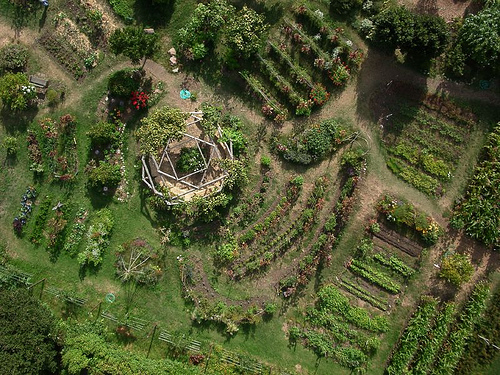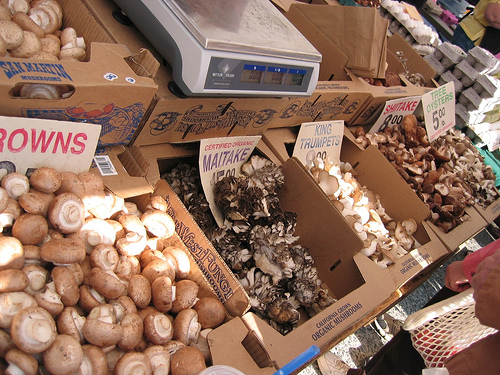Last night I saw the excellent documentary Ripe for Change, about new developments in food in California. It is part of a four-part series called California and the American Dream on PBS several months ago (to my horror, I missed it). The showing was hosted by Slow Food San Francisco; I learned about it because I am a member of Slow Food USA, “an organization devoted to preserving traditional foodways” (from their website description).
One of the producers was at the screening and spoke at length about outreach, meaning screenings. PBS misses lots of people, he said. As I say about research, no point doing it if no one learns about it. He can’t post the whole thing on Google Video because PBS owns the broadcast rights for three years. Ugh. First, PBS funds it, then prevents people from seeing it.

The film covers the Edible Schoolyard in Berkeley (aerial photo above) and attempts in Berkeley to improve school lunches. While writing The Shangri-La Diet, I looked into school gardens as a way to help kids eat better. I visited the Edible Schoolyard, where I was sorry to learn that the ten-year-old program receives $200,000/year in grants (a crucial fact I can’t find on their website) with no end in sight. When I talked with them, they seemed uninterested in reducing this dependency. Not very sustainable, much less repeatable. The Berkeley school lunch program is also in poor shape, although you wouldn’t know it from the film, one of its few shortcomings.

In contrast, farmer’s markets are doing great. The crucial step, said the film, was legalization, which happened while Jerry Brown was governor. Farmer’s markets are spreading everywhere, supporting thousands of small farms and artisanal producers, and providing healthier food. (Not to mention their social, entertainment, and educational value.) Could this be telling us something about how to improve school lunches? I think liberalization of the school kitchen laws and allowing lots of small producers to try to make a profit by providing healthy school lunches (giving kids vouchers, say) might go a long way. The current efforts are too top-down and too few brains are involved, I believe.
Before the film there was a short clip of Naked Chef Jaime Oliver trying to improve British school lunches. In what we saw, he was having trouble: the kids wouldn’t eat the food. (Just like in Berkeley.) Jaime Oliver, meet Antonia Demas, whom I wrote about in the last chapter of The Shangri-La Diet.
Seth
Hi – I’m the Director of Nutrition Services for the Berkeley Unified School District – I am proud of the work we’re doing & the progress we’re making. I’d love to chat w/ you; also show you our program if you like. Check out my website for more information; I look forward to speaking with you.
thanks
Ann